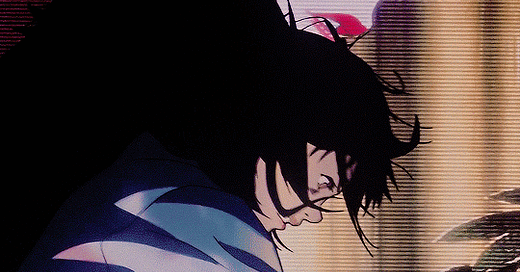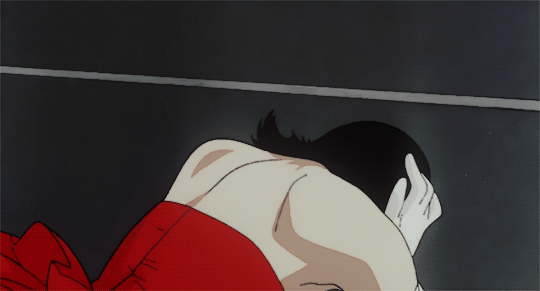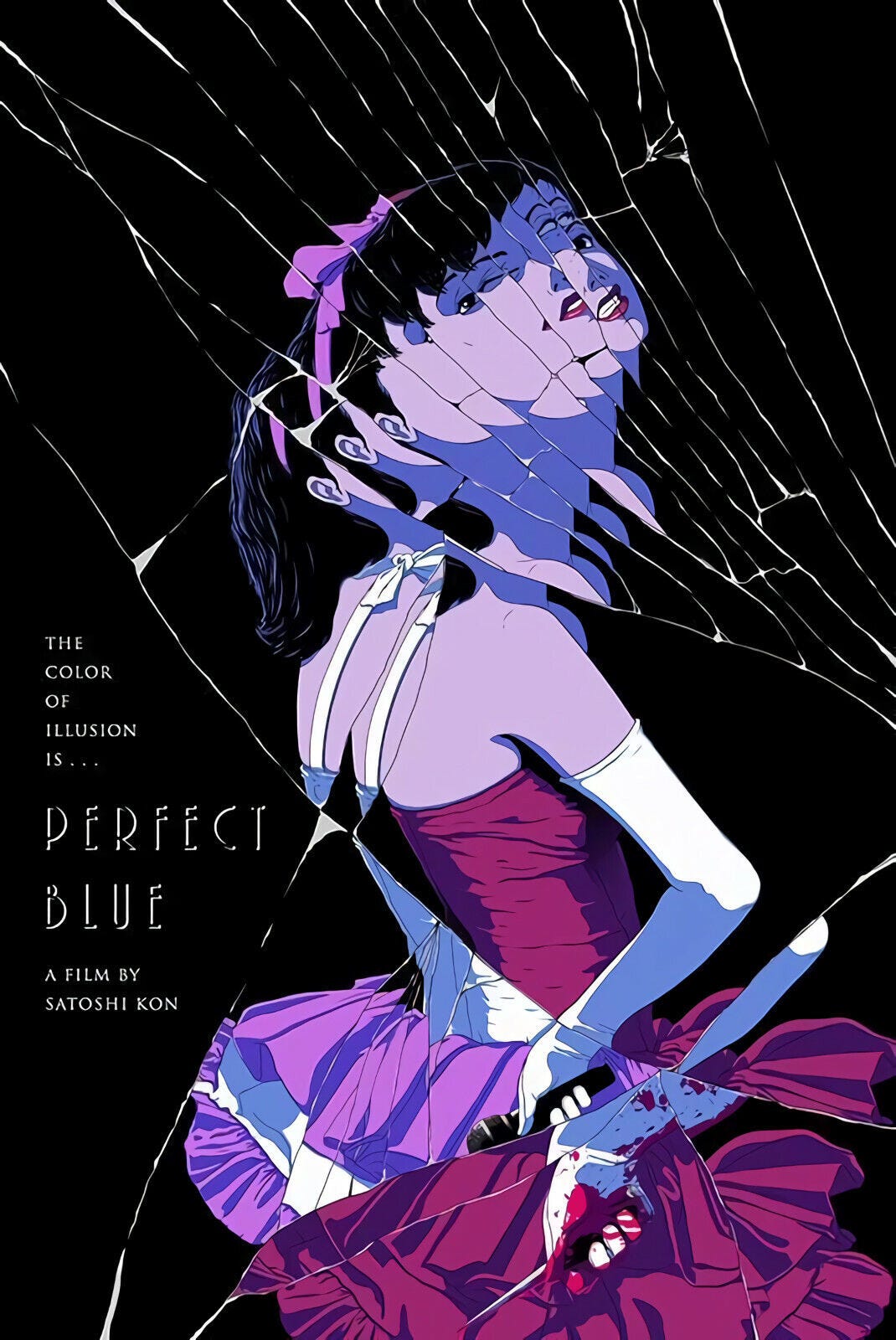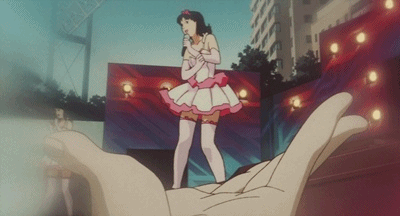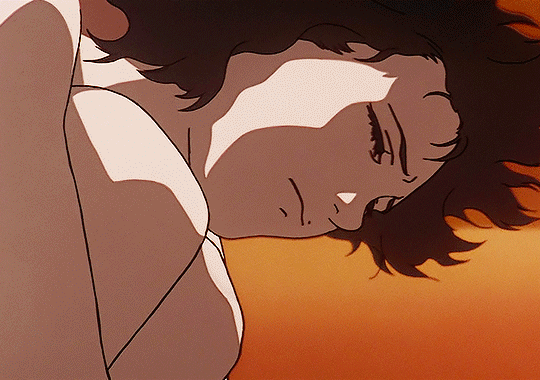Perfect Blue (1997) and the delicate art of the rape scene
(And how easy it is to send a complex message crashing to the ground)
Note: This essay contains spoilers for Perfect Blue.
It is a truth universally acknowledged that all self-respecting thrillers about female performers must at least flirt with identity fractures, sexual abuse, and lesbianism.
Perfect Blue, if you ask any anime purist, made the genre what it is (you’re a hack, Darren Aronofsky!), so it’s got plenty of all of those. Except lesbians. Lame.
For this blog, I want to zero in on the overused topic of sexual abuse, and how Perfect Blue went from a fantastic example of a rape scene done right to one done terribly wrong in twenty minutes flat.
Catching You Up on Perfect Blue
Obligatory movie recap.
Perfect Blue is a 1997 psychological thriller directed by Satoshi Kon, (vaguely) based on the 1991 slasher novel of the same name by Yoshikazu Takeuchi. While the novel is a straightforward story of a pop idol stalked by a jilted fan who, uh, wants to wear her skin, the movie packs on layers and layers of theme. In brief:
Kirigoe Mima retires from a middling idol group to become an actress instead. But her new career instantly makes staggering demands: sexy photoshoots, gory scripts, and a gang rape scene in her breakout role that she can’t say no to.
As IMDB so elegantly summarizes, she “goes insane” as the men who pushed her career in this racy direction turn up dead. A website called Mima’s Room records every second of Mima’s life…or an idealized version of it, where the stalker who writes Mima's “diary entries” imagines her as a sweet, virginal idol once more. Mima’s idol life haunts her figuratively and literally: now there’s girly, giggly apparitions in the mix, confusing her until she can’t keep track of her days or who she actually is.
Though Perfect Blue isn’t, well, perfect (all “perfect” puns from now on are entirely accidental), it’s gorgeous and packed with cutting symbolism, all pointed towards how famous women lose control over their identities. Their self belongs to their managers, fans, critics, and even their stalkers and abusers. Ironic, then, that Perfect Blue’s biggest fumble is in how it tries to criticize objectifying Mima while being unable to help objectifying her anyways.
“Is that the job that you wanted?”
Framing is everything, and I think the first rape scene masters it.
The scene is happening not, exactly, within the plot of Perfect Blue, but within the plot of the show Double Bind on which Mima is an actress; as such, the scene in Perfect Blue is criticizing the scene in Double Bind.
Mima is playing a dancer at a club. At the direction of the film team, she’s stripping, smirking, and seducing, surrounded by hooting and hollering older men. In the all-male greenroom, one of the producers croons, “Mmm, looks good! Ex-pop idols sure make a nice scene!”
As the assault starts in earnest, the focus is on Mima’s body and how she’s been directed to act: like a squealing, sobbing little girl, barely fighting, letting herself be exposed. Arms: wide! Tits: out! Her head’s thrown back off the edge of the stage, so the multi-angle cameras can capture the swell of her breasts and her screaming mouth all at once. Sexy. You can practically hear the director ordering the male actor to move his leg around Mima’s so the camera can get a nicely-framed shot of her underwear getting torn off.
All throughout, it feels as if the camera has been turned on the viewer: “Are you enjoying this like those creeps?”
As a commentary on how media treats sexual assault, this scene is effective and extremely uncomfortable to watch, in no small part because the framing essentially makes us moviegoers complicit in casting Mima as a sex object.
There’s been a lot said by smarter people about how rape in fiction has to earn its keep by being, essentially, treated rationally by the narrative. It must ripple out in the plot and character arc (or else why have it at all?), but it’s also overstayed its welcome by being the go-to trauma for sexually empowering female characters. Where I get hung up is on the literal representation—what are we looking at when we’re watching a female character get raped?
Every male director ever is insists I’m looking at something horrifying and disgusting. Yeah, sure I am. Is that why she’s posed prettily? Is that why the camera cares so much about keeping the bounce of her breasts in-frame? I just don’t buy it—I don’t buy the intentions of the crew or the writers, and I certainly do not buy the intentions of the viewers.
Let’s be real: in America alone, the third most common offence by current prisoners (of which 93.5% are men) is sex crimes. Oh, and that’s considering that only ~30% of sex crimes are reported to police. And that’s considering only 8% of offenders go to prison. Rape is a porn hashtag. We all know that in Japan, cell phone cameras are required to make shutter sounds, and there are women-only train cars to avoid upskirting and groping. We live in a culture where universities have to teach grown-ass men that rape is bad, actually (psst…they know. They just don’t care).
Like, come on: I was trying to find gifs/screenshots of Perfect Blue, and the sources led me to r/rape_hentai and various other sites that repost anime porn.
The fact that this scene is on a rape subreddit proves its inelegant point. The citizens in the world of Perfect Blue will watch Double Bind and post their own screenshots to their Reddit equivalent. In the film, a fan says that ratings went up after that episode because “the public at large are all idiots.”
Throughout this (pretty drawn out!) scene, the camera lingers on her distressed face, body, and exposed breasts. In the context of the in-movie crime drama, it’s clearly supposed to be a salacious scene. It recalls the worst examples from the Game of Thrones discourse, where the direction and writing seem more concerned with arousal than showing rape as horror or exploring the victim’s interiority.
The director yells, “CUT!”
Everyone goes still as the cameras and lighting are rearranged. One of the men on top of Mima whispers to her that he’s “so sorry.” She tells him it’s alright. It’s all part of the job, after all. Her female assistant, Rumi, had argued that a rape scene was too much (“It’s our job to protect the celebrities in our agency!”), but Mima said she’d do it—it’d make her a disappointment to everyone in the room if she backed out now. After all, her manager said that it’s “commonplace for actresses.”
Backstage, Rumi is watching the scene on a whole array of cameras. We now see that every shot in Perfect Blue—every shot on your screen, dear viewer—is actually a shot in Double Bind, and we can imagine that team of male editors playing and replaying Mima’s agony to pick the best angles.
Mima’s agonized (but sexy) face is projected all around, her cries coming from a half-dozen speakers, surrounding them, tinny and chaotic. Rumi storms out, tears pouring down her face.
Mima, meanwhile, starts dissociating or blacking out or maybe both. Her blank stare dissolves into blinding flashes of the set spinning around her. Maybe going limp is in the script, but dissociating is not. And yet no one stops to help her. No one checks in on her. Mima is a beautiful body to play with in HD.
Only when Mima returns home does she start crying and trashing her apartment, wailing, “Of course I didn’t want to do it!”
You can definitely say what many reviewers before me have said: in skewering the media’s titillating portrayal of sexual violence, Perfect Blue still made a titillating portrayal of sexual violence.
Is it a failure, then? Maybe. Not to this picky, smug bitch. There was no other way to frame the scene to get across the message they wanted, and I have never seen a film willing to convey that message at all. I don’t think films need to tell me rape is bad—we all know that. So the choice to portray it is always a little suspect. Perfect Blue agrees with me.
…Well, for now.
“I couldn’t trouble all the people who brought me this far!”: a further analysis
In the Double Bind scene, Mima is playing a stripper of sorts (an exotic dancer, one might say?). Her costume is similar to her pop idol outfit, down to the white-and-pink frills. It’s tiny, girlish, reminiscent of fetish-chic maid dresses. The comparison reveals how childish the stripper outfit is and how sexy the innocent idol outfit is. Surrounding Mima as she acts out a striptease are older men, leering, cheering, and laughing—it’s all an eerie reflection of the opening scene of the movie, where she’s performing with her idol group for the last time.
The author of the novel, Yoshikazu Takeuchi, said he was inspired to write by how the men around him in the idol fandom were obsessive—controlling—when it came to the image of their faves. That control is inevitably sexually-charged: they want their idols to be exactly as sexy/chaste as they demand. To fall over the line in either direction is to betray them. The novel’s version of the stalker character masturbates to purpose-recorded tapes of idols, but won’t dare do the same to his beloved, Madonna Mima.
Mima’s concert crowds are entirely men. The fans who read (and write for) Mima’s Room are men. The fans who buy her magazines are men. There are no scenes with female fans. The men demand everything of her.
The physical rape is a representation of how men have claimed control over Mima’s body and emotions. Men have always had unfettered access to her, and she must smile and, like she said to the actor playing the rapist, promise them it’s all a-okay. That actor apologized, sure, but he didn’t call time-out when she went blank and limp.
She’s given herself over to them completely now: her viewers have seen her naked body and they know what it looks like, emotionally feels like, to terrorize her. As movie viewers, thanks to the extra layer between us and Double Bind, we see a literal representation of what this amount of image control is doing to Mima—making her dissociate from herself, a theme that carries through the rest of the dizzying film.
“I’m sure she’s totally showing it off in front of the photographer. Like, TOTALLY!"
This is one of the few scenes that is more or less taken right from the novel. Mima’s new identity needs a new look—a new, adult, sexy look. Off she goes to a photographer who’s known for getting women to strip down on film.
She’s all smiles in the shoot, relaxed, effortless, almost naive. I don’t see this as her faking—I see it as her thinking she’s in control of the situation. However, it swiftly gets out of her control. Like with Double Bind, she can only express her regret when she’s alone in her apartment: she puts her head under her bathwater and screams, “Bastards!”
Soon after, she’s either imagining killing the photographer or actually killing him (we are deep in the “who is who and what is what” section now). His blood splatters projections of the photos he took of her—a mere surface stain. She can never be covered up completely.
The stabbing is intercut with split-second overlays of the photographs, revealing how violating they became once the scene ended. Some reviewers who share my criticisms of the third act also hate this scene because of how much they got away with thanks to it being animation. Blink and you might miss the shots of full bush (yay, 90s!).
In a way, I can agree that it was a little too much. After all, it’s annoying how when a movie explores male sexuality, it shows off naked women. When a movie explores female sexuality, it shows off naked women. When movie explores female sexual trauma, it shows off naked women.
However, maybe the scene was directed so well—I mean, the gif I inserted is iconic for a reason—that it just made me sad. It revealed how far that photoshoot went once “we” were out of the “room.” Once Mima was entirely alone. I left her with someone who wanted to hurt her, and I should have been there to stop him.
“Okay, take two!” (aka: It all goes downhill)
I haven’t mentioned him much before, but this film’s got a stalker.
He’s pulled straight from the novel: a creepy super-fan who wants Mima to be chaste and sweet (in this adaptation, however, he doesn’t want to wear her skin). He goes by his online handle, Me-Mania. So far, the dude hasn’t spoken a word, and I found him more annoying than scary (his design and voice work is about as subtle as if Hannibal Lector wore a blood-smeared bib and carried around a butcher knife).
So far, he’s been writing the Mima’s Room fake diary entries, beating up rowdy teens who heckle her, and buying every copy of the magazine with Mima’s sultry photoshoot in it—not to ogle them, but to keep them away from men who would. To Me-Mania, Mima the Idol has been replaced by a slutty, trashy imposter, and he’s resolved to get rid of her.
Oh, don’t worry. He wants to rape her first!
God damn it. What happened to good ol’ skin-wearing?
When [Me-Mania] actually appears at her workplace and tries to kill her […], the assault mimics the fictional rape in setting and direction. Again, Mima’s distress is sexualized and her body, not her experience, are emphasized.
The mimicry Brenan mentions is what makes this scene so baffling to me.
Satoshi Kon is, clearly, no idiot, nor is his team. They didn’t stumble into how so many shots mirror the Double Bind scene. For example, in both, she’s thrown onto her back on a circular stage at the end of a short catwalk; her head is tilted off the lip of the stage; the man is on his knees between her canted legs; her arms are thrown wide; her wailing is high and childish—if you’ve seen a single episode of any anime, you can imagine how it sounds.
One interpretation is that her reality and her fiction are melding together, so we’re meant to question if this is more like a trauma flashback to Double Bind or if it’s actually happening (doubtful, considering the straightforward way it's shot). However, what are we supposed to do with the mixed messaging on objectification?
That catwalk makes the comparison undeniable, but the scenes aren’t entirely similar. In this one, we get more bare breasts and lovingly painted nipples. Me-Mania rips off Mima’s shirt, chases her around, punches her in the gut, all so when he does finally throw her on the stage, we get a shot of some jiggle physics. Rad.
Even the over-the-top shots of Me-Mania’s drooling, sweating, monstrous face are part of the objectification: Mima is a perfect angel in comparison, about to be violated by this ugly, awful creature. I, uh, do not recommend you fact-check me, but if we head back to r/rape_hentai, the majority of the content is a pretty, small girl with a man or creature who is somehow grotesque. The humiliation is the point.
Here’s the tension that sets these two scenes at odds: if the Double Bind scene is not purposefully objectifying, then the Double Bind scene has no meaning to its objectification. If the Double Bind scene is purposefully objectifying, then this Me-Mania scene is more objectifying but without any meaning. Where does that put us?
Am I supposed to mine the Me-Mania scene, too, for meaning beyond “rape scary and bad”? Then I have the same question for this scene that I ask of all rape scenes, all scenes of women being hurt and conveniently nude: why couldn’t you care enough about her pain to stop ogling her?
“You’re tarnished! FILTHY!”
Thematically and logically, I think the purpose of the Me-Mania scene is on shaky ground, but one can make an argument for it. We’re circling back to the theme of men claiming women’s personhood, obviously.
But, uhh. Satoshi? I think that point was already made by how Me-Mania runs Mima’s Room (literally pretending to be her) and how he told her she’s not his Mima and also how he’s trying to murder her. What does a rape add to that message? Shock factor?
Circle back to ol’ skin-wearer from the novel, who is more or less identical in motivation to Me-Mania. Both of them are not sexually attracted to Mima in the way we normally think of it—Me-Mania hoards her smutty photoshoot to protect her innocence, and skin-wearer explicitly refuses to masturbate to her image for the same reason—but they are both sexually controlling in that they want her to be a perfect virgin. Me-Mania is convinced this Mima is an imposter, but why, then, would he want to sexually claim her since he has no attachment to her? Because she’s the Whore to Idol Mima’s Madonna, and therefore he is allowed to rape a ruined object? Well, I suppose it is a classic fiction move to give a male villain any possible reason to assault a woman, so whatever.
So where does all that put us? I’m not sure. I was inspired to write about this simply because of how much I appreciated the first scene (and the photoshoot scene), but felt total whiplash from the second. For a film with relatively strong interior logic when it comes to themes, how did this one fall through the cracks?
I have a couple other things to harp on: the unpleasantness of Rumi’s reveal as the villain, for one. Besides a lame use of the ultimate thriller shortcut, multiple personality disorder, Perfect Blue also delights in showing the ridiculousness of dumpy, fat, middle-aged Rumi squeezed into Mima’s idol dress. It contrasts beautiful, youthful Mima with slavering, slobbering Rumi as they chase each other through the city. If we take the Double Bind scene at face value, as the Me-Mania scene asks us to, and forget about the directors and film cameras directing Mima to be a manufactured fantasy ideal (young, thin, sexy), then we end up with a film that just does the same-old, same-old of saying fat older women are selfish monsters who hate pretty young girls. If we say the intentions of the cameras are paramount to understanding Double Bind and therefore to understanding the film, we can maybe see Rumi with a bit more empathy—this Perfect Blue world has no place for ugly women who can’t be objectified, so why wouldn’t she be desperate to be beautiful?
All that said, all those thoughts dumped out of my head and onto yours without warning, well…I think there should’ve been lesbians, actually.

